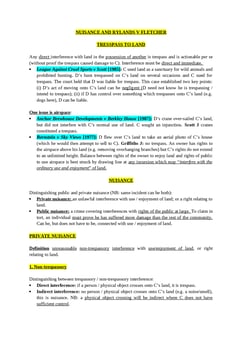Commissioner for Customs & Excise v Barclays Bank [2006] 4 All ER 256
Judgement for the case Commissioner for Customs & Excise v Barclays Bank
Table Of Contents
Plaintiffs sought an injunction to freeze X’s assets because X hadn’t paid tax owing. Defendant, the bank, received the order from the court but failed to freeze the assets.
Plaintiffs brought a claim for negligence against Defendant.
-
HL dismissed the claim since:
The injunction was enforceable through contempt of court actions, not private actions and
That since Plaintiff and Defendant were not in contact and nor was there any reliance on the bank Plaintiff, Defendant could not be said to have assumed responsibility.
Furthermore, since it would produce an unfair result (there was already a separate means of enforcement) it could not be considered fair, just and reasonable to impose a duty here.
Lord Bingham
-
3 types of tests for pure economic loss cases, based on negligent mis-statement or mis-performance have been suggested:
The incremental approach is of no value. 3-step approach is capable of vagueness and couldn’t ever really be more than broad guidances as to the type of situations that should be covered. The assumption of responsibility test is problematic because the “assumption of responsibility” is objective so that it really refers to the cases where the law would imply such an assumption, and the more objective the test become, the less likely it is that Defendant ever intended to assume responsibility.
He says whatever test is used, the key is to find a just solution and to determine if there was a duty of care based on the situation and the relationship between the parties.
Lord Hoffmann
Cases of economic loss caused by negligent mis-statement or mis-performance require the assumption of responsibility approach to determine proximity.
It is an objective test based on what “would reasonably be inferred from his conduct against the background of all the circumstances of the case” and once it is satisfied questions of “fair, just, etc.” don’t need to be addressed.
This is because it is the relationship itself that makes it fair, etc. to impose the duty. It is also because questions of fairness and policy, etc. factor into the decision as to whether there was an assumption of responsibility (this is because of the objectivity of the test that policy factors come in).
Lord Hoffmann concedes that it is not really a question of simple fact.
Lord Rodger
-
The assumption of responsibility does not fit all cases and is only one of the legitimate approaches. In this case he adopts the 3-step and says that:
There is no proximity and
It would not be fair, etc. to impose a duty.
Lord Walker
His analysis implies that the “assumption of responsibility” is a way of determining proximity within the 3-step approach, but says that the real question here is “fair, just and reasonable”.
Lord Mance
There are some cases which have not used the assumption of responsibility approach, e.g. Smith v Bush.
There is no single approach that can be used exclusively to determine liability in economic loss cases. 3-step provides a good framework but at a high level of abstraction.
He says that since voluntary assumption of responsibility is an assumption for the task and not for the legal effect, the 3 questions raised in Caparo are still relevant to determine if there was a legal duty.
He confines “assumption of responsibility” to cases “equivalent to contract”, which clearly is not the case here. The idea of an assumption of responsibility is strained in cases such as Spring where there was no option not to so act.
RELATED CASES
For Further Study on Commissioner for Customs & Excise v Barclays Bank
Need instant answers? Our AI exam tutor is here to help.
Ask questions 🙋 Get answers 📔 It's simple 👁️👄👁️
Our AI is educated by the highest scoring students across all subjects and schools. Join hundreds of your peers today.
Get StartedSimilar Cases
Related Product Samples
These product samples contain the same concepts we cover in this case.
| Tort Law | Actionable Damage Notes (19 pages) |
| Tort Law | Negligence Caparo V Dickman Test Notes (10 pages) |

 Since 2010, Oxbridge Notes has been a trusted education marketplace, supplying high-quality materials from top achievers at universities like Oxford, Cambridge, LSE, Harvard, and Yale.
Since 2010, Oxbridge Notes has been a trusted education marketplace, supplying high-quality materials from top achievers at universities like Oxford, Cambridge, LSE, Harvard, and Yale.